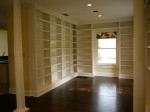 Selling your home? If you look at it as product for sale and not as your home, you’re more likely sell it quickly and profitably. Why? Because you’ll be able to detach from thinking of it as yours. You can then remove personal items and arrange your home to attract the widest amount of buyers. And don’t worry, you can bring all the great memories and personal items to your next home!
Selling your home? If you look at it as product for sale and not as your home, you’re more likely sell it quickly and profitably. Why? Because you’ll be able to detach from thinking of it as yours. You can then remove personal items and arrange your home to attract the widest amount of buyers. And don’t worry, you can bring all the great memories and personal items to your next home!
The key to effective staging is for you to detach from thinking of your home as your home and instead think of it as a product to be sold.
Here are Five Powerful Home Staging/Decorating Tips:
1- Walk up to your front door. Open it. What’s the first thing you see? That’s what prospective buyers will see when they open the door. It’s their first impression. It can’t be changed. Make sure what you see is not cracked, crooked, worn, smelly, dirty, or personal. In other words, no chipped paint, ill-placed artwork, tattered carpet, flowers in need of a water change, smudges on the mirror, or photos of your last family reunion.
2- How much natural light does your home have? Homes with lots of natural light sell quicker and at a higher price because people feel more energized and comfortable in the space. Make sure that all window treatments are open except if there’s an obvious unsightly scene outside. Turn on all the lights when you have a showing but avoid using flourescent lights unless you don’t have other options. If you’ve got a dark house you create more light by painting the interior walls yellow, cream or beige. And remove all clutter and superfluous furniture. Add accessories in these colors: red, bright orange and yellow. If it’s practical, install sky tubes which allow natural light from above and are less expensive than sky lights.
 3- Can you navigate easily through rooms and hallways? The furniture arrangement in each room must allow for lots of room and for ease when walking through the space. Remember that buyers are going to check out every room and will usually open closets. Make sure it’s easy for them to get there. You may have to rearrange furniture, but do what you need to in order create a good traffic flow through the space.
3- Can you navigate easily through rooms and hallways? The furniture arrangement in each room must allow for lots of room and for ease when walking through the space. Remember that buyers are going to check out every room and will usually open closets. Make sure it’s easy for them to get there. You may have to rearrange furniture, but do what you need to in order create a good traffic flow through the space.
4- By now most people know that personal family photos should not be on display when showing your home. But that’s not all. Remove animal skulls, deer antlers, animal-skin rugs, bones, mounted fish, photos of mounted fish, and anything else that’s no longer with us. You don’t want to turn off anyone that has an aversion to these type of dead things. Also trophies, swords, knives, and aggressive images are best removed. Conversely, religious icons should be put away prior to showing your home. You don’t want to limit buyers who may have judgments against certain religions.
 5- In each room, look up and look down, open all closets and cabinets and assess the dirt situation. Then clean, scrub, vacuum, polish, dust, wipe, sweep, and deodorize as necessary. No time? Hire a cleaning service to do it for you. It’s very important that buyers feel immediately comfortable in the house. Picture yourself checking into a hotel and finding dust bunnies under the bed or fingerprints on the mirror. It leaves a bad impression and you don’t feel comfortable. The same principle applies here.
5- In each room, look up and look down, open all closets and cabinets and assess the dirt situation. Then clean, scrub, vacuum, polish, dust, wipe, sweep, and deodorize as necessary. No time? Hire a cleaning service to do it for you. It’s very important that buyers feel immediately comfortable in the house. Picture yourself checking into a hotel and finding dust bunnies under the bed or fingerprints on the mirror. It leaves a bad impression and you don’t feel comfortable. The same principle applies here.
Good luck with selling your home and remember that these tips can be used even if you’re not selling your home. They’re good Feng Shui!




![Fotolia_1033648_M[1]](https://balanceaustin.files.wordpress.com/2010/06/fotolia_1033648_m1.jpg?w=150&h=102)








